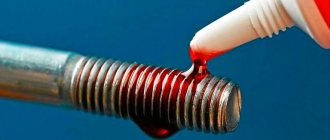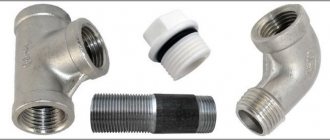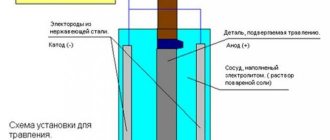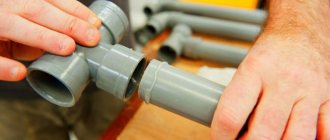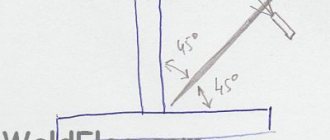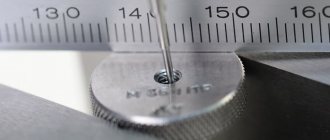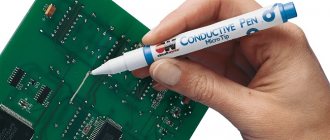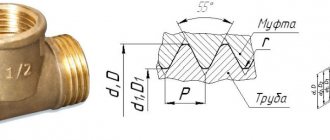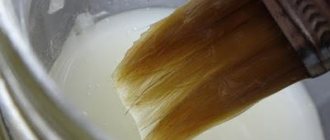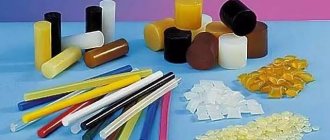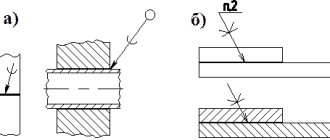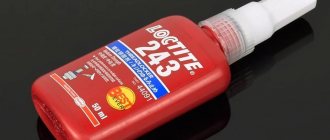The thread locker helps to increase the clamping force between screwed connections, that is, to prevent spontaneous unwinding, and also to protect the connecting parts from rust and sticking.
There are three main types of retainers available - red, blue and green. Reds are traditionally considered the “strongest” and greens the “weakest”. However, when choosing a particular fixative, you need to pay attention not only to the color, but also to the performance characteristics given on their packaging.
The strength of the fixation may depend not only on the color, but also on the manufacturer. Therefore, the end consumer has a reasonable question: which thread locker to choose? And to help you make your choice, here is a list of popular products, which was compiled based on reviews, tests and studies found on the Internet. As well as a description of the characteristics, composition and selection principle.
Why use thread lockers?
Thread adhesive is able to complete polymerization when there is no access to air, resulting in an ideal connection of pipe parts, for example, in a water supply system. This avoids water leakage, gas escaping, etc. It also prevents parts from unscrewing under the influence of vibration and mechanical influences.
Using thread adhesive is simple, and there are different forms of similar compounds available. This allows every master to find a convenient option for his work.
Thread adhesive is able to complete polymerization when there is no access to air, resulting in an ideal connection of pipe parts, for example, in a water supply system.
Advantages and disadvantages
Thread sealant for bolts stands out for its ease of use, which is why they are often chosen. The popularity of the products is also due to the positive properties described below:
- After applying the product and drying, they do not move or shrink;
- Additional protection of the metal from rusty formations is created;
- The presence of different types of compositions facilitates their use for parts of different sizes;
- Adhesives for bolted joints prevent loss of fixation force, withstand vibration loads, as well as impact;
- Their consistency allows the composition to penetrate into the smallest crevices, providing an airtight seal.
Stop thread sealant also has disadvantages:
- Reinforced types of means do not make it possible to easily unscrew the threaded rods if necessary, then they resort to high-temperature exposure or special tools;
- When choosing, take into account the specifics of the material so that the composition does not damage its integrity;
- Adhesives dry quickly, so it is necessary to accurately apply the layer; it will be impossible to change the position of the bolts, and it is impossible to return the composition to a liquid state;
- You should not use adhesives at low temperatures, this affects how long the layer will take to dry, the period will become longer.
Thread sealant for bolts stands out for its ease of use, which is why they are often chosen.
Features and Benefits
Sealant is a thread locker, an acrylic adhesive composition capable of maintaining fluid properties for more than a year when stored in ordinary containers. When a substance comes into contact with metal, radicals are formed, which in a closed space (between parts) form compounds with oxygen. An oxygen-free environment is created. As a result of the reaction, the fixative hardens.
Classification of metals according to the degree of interaction with anaerobic glue at room temperature:
| Metal activity level | Name | How long does it take for thread locker to dry? |
| Active | Copper, iron, cobalt, brass, bronze, cast iron, steel | Up to 3 hours |
| Passive | Zinc, aluminum, silver, cadmium, chromium | 5-7 hours |
Surfaces are ready for use after 5~24 hours. An increase in ambient temperature leads to an acceleration of the hardening process.
Advantages of threadlockers:
- Speeding up the assembly of structures.
- Resistance to acids, alkalis, oils, organic solvents.
- Retains properties in a liquid medium, under pressure changes, and in a vacuum.
- Provides vibration resistance and sealing to the connection.
- Prevents metal corrosion.
- The application process can be automated.
- When using activators, non-metallic parts can be glued.
- Possibility of connecting parts from materials of different structures (metal-plastic, ceramics-metal).
Flaws:
- Used for threads no larger than M80.
- Increased fixation time at temperatures below room temperature. To speed up the process, the use of an activator is required.
- The thread surface must be clean, grease-free and dry. Pre-treatment of the thread with a cleaner is required.
Composition of thread locker
The instructions for each product specify the components used in production. Each type will include different components, so you should carefully study the composition before purchasing. The level of connection depends on the composition, and determines the resulting properties.
The level of connection depends on the composition, and determines the resulting properties.
How to Choose the Best Thread Locker
To get a high-quality result, you need to choose the right composition for the task. In this case, the criteria that influence the result are determined. Experts advise paying attention to: fixed moment of resistance, state of aggregation, resistance to process fluids, polymerization time.
To get a high-quality result, you need to choose the right composition for the task.
Fixed moment of resistance
This parameter helps you understand what size bolt the product will be suitable for. If the composition is intended for small bolts, then it will not be possible to obtain reliable fixation of large ones. Conversely, when small bolts are attached to reinforced clamps, then unscrewing them may become impossible. But manufacturers do not always specify this parameter.
This parameter helps you understand what size bolt the product will be suitable for.
State of aggregation
There are paste and liquid thread lockers. The first option is not so convenient to use, but they will not spread to unnecessary areas. Liquid types are standard for hard-to-reach bolts, but may bleed.
When choosing, take into account the size of the thread; the larger it is, the harder the option should be chosen for gluing.
When choosing, take into account the size of the thread; the larger it is, the harder the option should be chosen for gluing.
Resistant to process fluids
When operation involves exposure to different liquids, then when choosing a composition, you need to pay attention to indicating whether the layer can withstand this influence. If there are no such requirements, then you can choose any composition.
When operation involves exposure to different liquids, then when choosing a composition, you need to pay attention to indicating whether the layer can withstand this influence.
Polymerization time
The drying time for adhesives varies; they begin to perform their function only after the drying stage is completed. Manufacturers write how long it takes for complete polymerization. For urgent repairs, this parameter will be important.
The drying time for adhesives varies; they begin to perform their function only after the drying stage is completed.
Value for money
One of the most important parameters is obtaining good quality at an affordable price. Here it is better to focus on popular brands that have proven themselves as high-quality adhesives. They will be discussed in detail below.
One of the most important parameters is obtaining good quality at an affordable price.
How to work with thread glue
When using a retainer, it is distributed over the area where the nut should be, a thin layer is made, optimally up to 5 millimeters thick. When the parts begin to tighten, the glue will spread over the entire surface, ensuring reliable fixation.
When working with blind cracks, the product is applied to the bottom and not to the threaded area. It is recommended to clean and dry the part in advance. Also, better adhesion is achieved by treating the metal surface with a special brush.
When using a retainer, it is distributed over the area where the nut should be, a thin layer is made, optimally up to 5 millimeters thick.
Types of thread fixation
Previously and to this day, to prevent loosening of the connection, the following is used:
- locknuts;
- Grover washers;
- using tension – plastic deformation of the connection into an ellipse;
- polyamide retaining ring in the nut body;
- welding, soldering;
- thread reaming and other methods.
All of these methods are not always reliable and require more complex assembly technology. There is a simpler and surer way to avoid self-unscrewing of parts - the use of anaerobic sealant (glue).
How to Unscrew a Thread Locker
An option for unscrewing bolts that were locked using clamps is temperature exposure. For different fixation levels you will need different temperatures: for red – 200-250 degrees; for blue – 100 degrees; the green type can unscrew at lower temperatures. The heating tool is a soldering iron or a hair dryer.
An option for unscrewing bolts that were locked using clamps is temperature exposure.
Thread adhesives provide a high level of thread bonding and can withstand varying degrees of stress. When choosing, take into account the operating conditions in order to use a type of product that is sufficient in terms of adhesion force.
Thread locker to prevent it from unraveling
Often it is necessary to tighten a bolt or screw so that it does not unwind, at least on its own, under the influence of the environment. The subject of this review is intended to solve this problem. Below the cut is a review and test drive of an anaerobic gel for fixation. When I wrote about anaerobic sealant, there were many questions in the comments about its capabilities for fixing threads. I replied that there are other products for this, and we will consider one of them. In conditions of a consistently unstable exchange rate, Russian-made products often turn out to be more interesting than their foreign counterparts. When I ordered pipe sealants, I also added this fixative to the cart. Delivery from the manufacturer is paid up to a certain amount (500 rubles - 6.5 $), so it makes sense to get goods up to this amount. Now I got around to dealing with this product. The parcel arrived in about a week and a half, the manager of the transport company called and arranged delivery. The main product there was, of course, Plumbermaster gel, which caused a great response among readers. I ordered the thread locker as an extra.
Here is what the manufacturer writes about this clamp (I have summarized a little information from different places on the manufacturer’s website): - replaces lock washers, reliably fixes bolts over M20; — can be used in joints from -0.2 to +0.6 mm, to fill microdefects in welds, castings, rolled products, pressed materials; - sealing immediately after application (final polymerization occurs after 15-30 minutes - the product blocks the part); — strong tightening is not required during assembly; — resistance to abrasion, high mechanical loads, and temperature changes; — protection against corrosion due to high adhesion to metal; — resistant to organic solvents; - does not creep, does not shrink, increases structural strength; — operating temperature range from -60 to +150 °C; — dismantled with heating up to +150 ºC; - Protects threads from corrosion.
Well, let's check its properties. In general, it is very important to fix the threads, especially in moving parts. For me, thread locker was very helpful in ensuring the stability of the connections in the automated greenhouse design I described here.
The thread locker is packaged in a blister:
It should be noted that they are available in 4 types: with easy-to-disassemble fixation, durable, for large threads and high-strength. We have the light version in our hands: with easy-to-disassemble fixation. On the reverse side instructions for use:
Weight with packaging 27 g:
The tube can be removed very easily, the weight of the tube is 14g:
Tube length is about 12 cm:
The cap on the tube is fixed with a thread; inside there is a bluish gel:
The tip of the tube is thin, which, combined with pressing on the tube, makes it easy to dispense the dispensed gel.
I’ll write down the features of these gels right away to avoid unnecessary questions. Gels are anaerobic - that is, they harden without air. In narrow places, in particular, at the point of contact between a nut and a bolt, or a self-tapping screw and a twisted surface, the amount of air is minimal - that’s where this gel polymerizes. The remaining gel on the outside does not harden and should be removed with a cloth.
For tests, let's take a few bolts and nuts. The seller claims to work even on M20 thread bolts, but the maximum I had was M10:
The candidates lined up are:
Lubricate 3-4 turns on each bolt:
From a large bolt, part of the gel flows onto a piece of paper; it is quite liquid, so it is probably better not to place it horizontally after lubricating it. We collect the compounds and wait for polymerization for 30 minutes:
On the left side of the piece of paper is a puddle left by a large bolt.
While the polymerization process is underway, I decided to assemble another structure. After the last review of anaerobic pipe sealant, people wrote in the comments about a vibration test. This time we can’t do a pressure test, but I think we can get vibration. What could be better suited for such tests than a children's metal construction set? I didn't find anything better and borrowed the following from the child:
Inside, as you would expect, there are structural elements and screws with nuts:
We will not assemble an airplane or a tractor, we will assemble a simple spear like this, using a simple tool from the construction set (the screwdriver fits into the screw slot with great force, uncharacteristic for children of the age indicated on the construction set - we will leave this to our conscience class=»aligncenter» width=»800 ″ height=”600″[/img] At the same time, I twisted the right part, marked with a blue marker, using our thread locker. I note that I twisted the screws with the same force, without fanaticism, but so that it would hold. Let’s leave the simple design to dry.
In the meantime, the moment of truth has come for our bolts, we try to unscrew them (30 minutes have passed). I was unable to turn the nuts by hand, but with the help of an adjustable wrench, the screwed nuts began to move with medium force. If you need to assemble a non-dismountable connection, you should resort to versions with strong and high-strength fixation. The polymerized sealant looks like this:
Now let's move on to our constructor. To create vibration, I decided to use a compressor that survives the winter on the balcony:
We fix our structure with clothespins, we don’t need strength, rather the opposite - the more it dangles, the better:
We turn it on and see how the structure vibrates. After 5 minutes of work, the structure changed its original appearance:
We can conclude that the thread locker helps to cope with the self-unscrewing of bolts and screws.
In general, we can say that the thread locker copes with its task; no problems arose when using it. The threaded connections fixed with this gel in my greenhouse did not cause any problems. So I can recommend it.
For dessert, the vibration video, unfortunately, did not wait for the collapse of the half without sealant:
Thanks to everyone who read to the end, I hope this information will be useful to someone.
